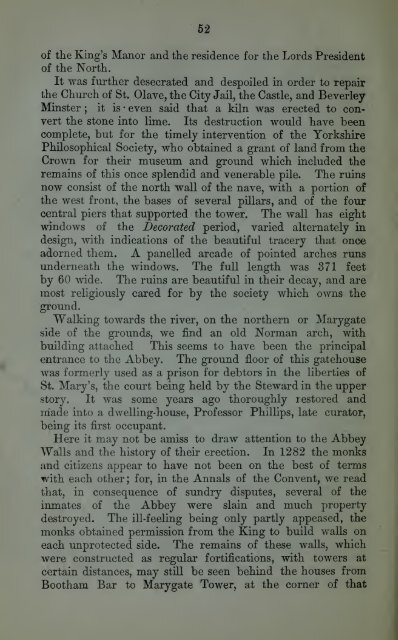practicalguideto00unse_0
Create successful ePaper yourself
Turn your PDF publications into a flip-book with our unique Google optimized e-Paper software.
52<br />
of the King's Manor and the residence for the Lords President<br />
of the North.<br />
It was further desecrated and despoiled in order to repair<br />
the Church of St. Olave, the City Jail, the Castle, and Beverley<br />
Minster ;<br />
it is • even said that a kiln was erected to convert<br />
the stone into lime. Its destruction would have been<br />
complete, but for the timely intervention of the Yorkshire<br />
Philosophical Society, who obtained a grant of land from the<br />
Crown for their museum and ground which included the<br />
remains of this once splendid and venerable pile. The ruins<br />
now consist of the north wall of the nave, with a portion of<br />
the west front, the bases of several pillars, and of the four<br />
central piers that supported the tower. The wall has eight<br />
windows of the Decorated period, varied alternately in<br />
design, with indications of the beautiful tracery that once<br />
adorned them. A panelled arcade of pointed arches runs<br />
underneath the windows. The full length was 371 feet<br />
by 60 wide. The ruins are beautiful in their decay, and are<br />
most religiously cared for by the society which owns the<br />
ground.<br />
Walking towards the river, on the northern or Marygate<br />
side of the grounds, we find an old Norman arch, with<br />
building attached This seems to have been the principal<br />
entrance to the Abbey. The ground floor of this gatehouse<br />
was formerly used as a prison for debtors in the liberties of<br />
St. Mary's, the court being held by the Steward in the upper<br />
story. It was some years ago thoroughly restored and<br />
raade into a dwelling-house, Professor Phillips, late curator,<br />
being its first occupant.<br />
Here it may not be amiss to draw attention to the Abbey<br />
Walls and the history of their erection. In 1282 the monks<br />
and citizens appear to have not been on the best of terms<br />
with each other; for, in the Annals of the Convent, we read<br />
that, in consequence of sundry disputes, several of the<br />
inmates of the Abbey were slain and much property<br />
destroyed. The ill-feeling being only partly appeased, the<br />
monks obtained permission from the King to build walls on<br />
each unprotected side. The remains of these walls, which<br />
were constructed as regular fortifications, with towers at<br />
certain distances, may still be seen behind the houses from<br />
Bootham Bar to Marygate Tower, at the corner of that















